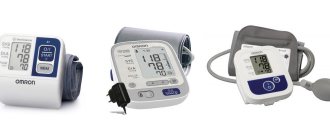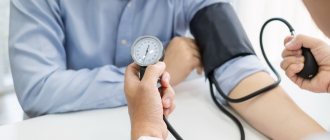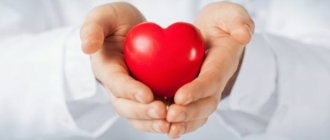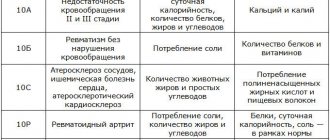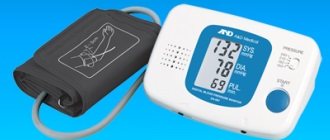Blood Pressure Control
Blood pressure at rest should not exceed 135/85 mmHg.
It is impossible to feel an increase in blood pressure, which is why many patients with arterial hypertension are not even aware of their illness.
The only way is to regularly measure your blood pressure.
When performing physical activity, blood pressure increases, and this is a reflection of the body's normal, physiological response to stress. Therefore, in order to detect arterial hypertension, blood pressure is measured at rest. Blood pressure is recorded as two numbers (for example, 120/70 mmHg) - the first number (systolic pressure) indicates the pressure in the arteries during the heart's contraction (called "systole"), the second number (diastolic pressure) indicates the pressure during relaxation of the heart muscle (“diastole” of the heart).
Blood pressure is measured using a device called a tonometer. Tonometers are automatic, they are quite convenient to use, however, the accuracy of measuring pressure with automatic tonometers is usually inferior to the method of measuring blood pressure used by doctors.
Rules for measuring blood pressure:
It is advisable to measure blood pressure at the same time of day.
Blood pressure is measured at rest - usually in a sitting position, after 5-10 minutes of rest.
In order to measure blood pressure using the Korotkoff method, you must have a special inflatable cuff with a pressure gauge and a phonendoscope.
The blood pressure cuff is placed on the shoulder. It is important that the cuff size matches the patient's shoulder size. The cuff is applied so that its lower edge is 1-2 cm above the elbow. The head of the phonendoscope is installed in the elbow bend, and headphones are inserted into the ears. Then, using a bulb, they begin to inflate the cuff. The cuff is inflated until the pulse in the wrist artery disappears (it is advisable that the pressure in the cuff exceeds the pressure at which the pulse in the wrist disappears by about 20 mmHg after the pulse disappears).
After this, the air is gradually released and the cuff is deflated. Once the pressure in the cuff equals the pressure in the artery, pulse sounds can be heard through the headphones of the stethoscope. The pressure in the cuff at the moment the first pulse sound appears will correspond to the systolic blood pressure.
As air deflates from the cuff, the pressure in it decreases and soon pulse sounds cease to be heard. The pressure in the cuff at the moment the pulse sounds disappear corresponds to diastolic blood pressure.
For greater accuracy, it is advisable to measure the pressure several times (2-3 times) with an interval of 2-3 minutes.
People with hypertension are advised to measure their blood pressure daily and record the readings in a diary.
How is hypertension diagnosed?
The study of pressure indicators is done in three ways: independently (self-monitoring of blood pressure), clinical blood pressure and 24-hour blood pressure monitoring (ABPM). In this case, the measurement criteria will differ.
Measuring blood pressure in a medical facility
When visiting a cardiologist or therapist, pressure should be measured twice on the same arm, 1–2 minutes apart. And one more additional measurement if the difference between the first two is more than 10 mm Hg. The blood pressure level is the average of the last two measurements. With a single measurement, a decrease or increase in indicators may be episodic (anxious thoughts, recently drunk coffee).
Hypertension is registered if, after two visits to the doctor, the tonometer shows more than 140/90 mmHg with double measurements. Art.
To clarify and confirm the diagnosis, the doctor prescribes independent monitoring.
Features of individual clinical situations
In some cases, self- and clinical blood pressure measurements may differ. Discrepancies require special attention, since it is more difficult to determine the presence of pathology.
"White Coat Hypertension"
It happens that when measuring blood pressure in a clinic, the tonometer consistently shows 145/85, while when measuring it independently at home, it is no higher than 130/80. This is a typical case of “white coat hypertension” - a condition when elevated levels are recorded only at a doctor’s appointment. This effect is called a pressor response.
“White coat hypertension” most often occurs due to increased anxiety in a medical institution, when a person is worried at a doctor’s appointment, but according to ABPM (24-hour blood pressure monitoring) or HABP (home blood pressure monitoring) outside a medical institution, the blood pressure level is adequately controlled. This condition can occur at any age, but patients over 60 years of age with a persistent increase in systolic blood pressure (isolated systolic hypertension) are especially susceptible to it. Such patients may have asymptomatic target organ damage, so they are examined and, if necessary, drug therapy is prescribed. White coat hypertension is associated with a higher risk of developing type 2 diabetes and persistently elevated blood pressure, as well as increased cardiovascular risk.
If patients do not have risk factors and target organ damage, the doctor will recommend lifestyle changes and regular monitoring
Masked hypertension
“White coat hypertension” has an antipode - masked hypertension. During examination in the clinic, patients have normal blood pressure - less than 140/90 mm Hg. Art., - however, self-measurement or daily monitoring records higher rates. The risk level for this condition is equivalent to stable hypertension, so patients are prescribed not only research and lifestyle changes, but also drug therapy.
To exclude doubtful situations and confirm the diagnosis, based on the examination results, the doctor will recommend monitoring the condition outside the clinic.
Measuring blood pressure at home
When self-monitoring blood pressure, measurements should be taken twice a day - in the morning and in the evening. It is important to follow the rules: the cuff must be selected in size, the hand must lie at the level of the heart, physical and emotional peace is maintained. You cannot talk during the procedure
The optimal time for self-control: in the morning before breakfast, within an hour after waking up (from 06:00 to 09:00), and in the evening - before dinner or at least 2 hours after dinner (from 18:00 to 21:00)
The obtained indicators must be recorded in a table, making sure to indicate the date and time of measurement. In doctors' terminology, this is called a blood pressure control diary. The table may also indicate heart rate, general health, and other data. For example, it is better to write down situations where performance increases due to a stressful environment so that the reason is clear. It is also advisable to note self-administration of antihypertensive drugs in a diary.
The table can be downloaded on the Internet or made yourself. She does not have an approved form, the main thing is that the entered data is clear to the doctor
When is self-monitoring of blood pressure and blood pressure recommended?
- “White coat hypertension” is in question (based on the results of 1-2 visits to the doctor).
- “Masked” hypertension as a possible diagnosis.
- 1st degree of hypertension - to create a complete picture of the condition.
- High (or so-called high normal) pressure at a doctor's appointment with a low cardiovascular risk and the absence of target organ damage.
- Normal blood pressure at a doctor's appointment in the presence of target organ damage and high cardiovascular risk.
- Sharp fluctuations in blood pressure at the same doctor’s appointment and during different visits.
- Various types of hypotension, or low blood pressure: during daytime sleep, after taking medications, when changing body position from horizontal to vertical.
- Suspicion of preeclampsia in pregnant women.
- Suspicion of resistant (poorly amenable to combination therapy) hypertension.
The term “cardiovascular risk” defines the risk of developing cardiovascular diseases and their complications. Hypertension is one of the leading risk factors.
Measuring blood pressure in a medical facility provides enough information to make a diagnosis and select therapy. But in some situations, the doctor may prescribe 24-hour monitoring using a special device.
24-hour blood pressure monitoring
The most accurate way to diagnose hypertension is 24-hour blood pressure monitoring (ABPM). A cuff with an electronic control device is fixed on the patient’s shoulder, which automatically pumps air and records the readings once every half hour during the day and once every hour at night. Such a study reflects a complete picture of pressure changes over 24 hours.
The exact information that ABPM provides:
- daily index - the difference between daytime and nighttime pressure;
- daily rhythm of pressure changes;
- blood pressure level during sleep - if it does not decrease by 10-20% by the middle of the night, this indicates a high risk of complications for the heart and circulatory system;
- dynamics of changes in the early morning hours - the period from 4 to 10 am is considered the period of the highest rise in pressure. At this time, the sympathoadrenal system, which regulates almost all physiological functions of the body, enters the mode of greatest daily activity.
If, based on monitoring results, the average daily pressure is 130/80 mm Hg. Art. or exceeds these figures, the diagnosis of arterial hypertension is considered confirmed.
Daily monitoring is also interesting from the point of view of studying lifestyle, as it reveals pressor reactions - the body’s response to physical activity, emotional stress and other stimuli. For example, sharp increases in pressure during working hours and its stable decrease outside of work are a direct indicator of the maximum level of stress in specific conditions.
When is daily monitoring prescribed?
- Significant discrepancy between clinical and home measurements (20 mmHg or more).
- Suspicion of nocturnal hypertension or increased night pressure - for example, with chronic kidney disease or nocturnal breath-holding.
- To collect additional data about the disease, assess the circadian rhythm and range of pressure changes.
- In all situations where home monitoring of the condition is recommended, 24-hour monitoring may be prescribed in addition to it - at the discretion of the doctor.
The essence of the method of 24-hour blood pressure monitoring
ABPM is a continuous monitoring of blood pressure (BP) over 24 hours.
A special device measures the patient's systolic and diastolic blood pressure and pulse by analyzing pulse phenomena in a pneumatic cuff (oscilometric method) or recording sounds (Korotkoff sounds) through a microphone from the brachial artery (auscultatory method). To pump air into the cuff and record the results of the study, a recorder is used (it is secured to the belt with a belt); a cuff, similar to the one used in electronic blood pressure monitors, is attached to it using a flexible tube. The recorder used in medical practice differs from a conventional automatic tonometer in its higher accuracy class. To capture and decrypt data, the device is connected to a computer.
The undoubted advantage of the ABPM technique is that the device records the slightest fluctuations in blood pressure with high accuracy, therefore, with the help of this study, the doctor receives a much more accurate idea of the patient’s blood pressure than from self-measurement of blood pressure. Also, the advantages of the ABPM technique include frequent measurement of blood pressure and measurement of blood pressure during sleep, which makes it possible to accurately assess arterial hypertension and detect an increase in blood pressure during sleep.
1 Diagnosis of hypertension at MedicCity
2 ABPM in “MedicCity”
3 Examination for hypertension
Enlist the support of loved ones
Support from family and friends can help improve your health. They may encourage you to make lifestyle changes to reduce your blood pressure.
If you need support outside of family and friends, you may want to consider joining a support group. People who have successfully resolved their problems can give you an emotional or moral boost or offer practical advice to cope with your condition.
Beware of stressful situations
Chronic stress is an important factor in raising blood pressure. Take some time to think about what makes you feel nervous or uncomfortable. Once you understand what is causing you stress, think about how you can eliminate the cause or reduce your stress load.
To manage stress in a healthy way without raising your blood pressure, try:
- Change your expectations. Learn to say no and live within reasonable limits. Try to learn to accept the things you cannot change.
- Monitor problems and create a plan to solve them. You can talk to your boss about difficulties at work or your family members about problems at home and together try to solve them as soon as possible.
- Understand what triggers stress. Of course, it is impossible to eliminate all stress triggers. But you might, for example, spend less time talking to people who bother you or avoid driving during rush hour.
- Take time to relax. Try to enjoy what you are doing and spend 15 to 20 minutes a day sitting quietly and relaxing.
- “Practice gratitude.” By expressing gratitude to others, you can reduce your stress load and eliminate thoughts that cause anxiety.
Lose extra pounds and watch your figure
Blood pressure often increases as weight increases. Excess weight can also cause trouble breathing during sleep (sleep apnea), which further increases your blood pressure.
Weight loss is one of the most effective lifestyle changes for controlling blood pressure. So, according to research, losing just 4.5 kg can already help lower blood pressure.
Pay special attention to the waist. A waist circumference of 102 cm for men and 89 cm for women significantly increases the risk of high blood pressure.
Interpretation of ABPM results
After the procedure is completed, the data from the recorder is transferred to a computer, where it is automatically processed.
Blood pressure numbers (like pulse) are a value that depends on the circadian rhythm. In the morning and daytime hours, blood pressure and pulse levels are higher, while at night, lower values are typical.
Normal blood pressure levels in an adult range from 110/70 to 130/80 mm. rt. Art. The ABPM device, in addition to the average blood pressure figures (systolic blood pressure - SBP and diastolic blood pressure - DBP) per day/day/night, records the variability of the circadian rhythm, i.e. fluctuations in SBP and DBP up and down from the resulting average daily curve. In addition, the daily index is displayed, i.e. the difference between daytime and nighttime blood pressure readings as a percentage.
A daily index of 10-20% can be considered normal. This means that the average “nighttime” blood pressure numbers should be less than the “daytime” ones by at least 10%. Blood pressure variability is considered abnormal if at least one of the measurements produces numbers above or below normal blood pressure values.
Various indices of hypertension, the time and speed of the morning rise in blood pressure, and pulse blood pressure are also determined.
An increased risk of cardiovascular complications is determined (with increased variability of blood pressure, increased pulse blood pressure, with an increase in the time and speed of the morning rise in blood pressure).
However, only the attending cardiologist involved in functional diagnostics can judge the norm and deviations from it. It is his experience and qualifications that will allow him to correctly interpret the ABPM results and make a conclusion about the patient’s condition.

